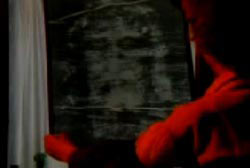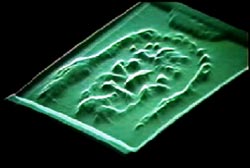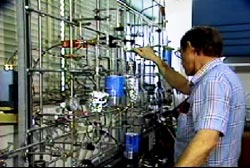|
Has carbon testing finally revealed the age of the Shroud of Turin?  The Shroud of Turin  Is this the face of Jesus? CASE DETAILS The face of Jesus Christ has inspired artists throughout the ages. But how did they know what Jesus looked like? A piece of linen may hold the answer. It is called the Shroud of Turin. Many believe it is the actual burial cloth of Jesus Christ, and his image was imprinted on its threads. Fr. “Kim” Dreisbach, Jr. has spent the majority of his career studying the shroud:
 A computer image of the Shroud The shroud was first exhibited publicly in France during the Renaissance period. No one seemed to know where it came from. Then in 1578 A.D., the shroud was moved to Turin, Italy, where it was rarely shown in public. Three centuries later, in 1898, the shroud was photographed for the first time. According to Fr. Dreisbach, the photographer’s negatives showed more detail than could be seen by the naked eye:
From that point on, the Shroud of Turin became more and more an object of scientific inquiry. Dr. Robert Bucklin, a forensic pathologist, has examined life-sized photographic negatives of the shroud:
The crucifixion of Jesus has traditionally been depicted with nails driven through his palms. But according to Fr. Dreisbach, modern research has confirmed that at the time of Jesus’ death, nails were driven through the victims’ wrists:
 Carbon dating was performed In 1978, the shroud was made available to a number of scientists for the first time. Using particles lifted from the shroud with adhesive tape, biophysicist John Heller and chemist Alan Adler determined that there was blood on the cloth. They found chemical evidence of severe torture, consistent with crucifixion. Their findings however, are not universally accepted. Some scientists, like Dr. Walter McCrone, have claimed that the shroud is a forgery—the work of a highly skilled artist who painted with tiny brush strokes:
However, Fr. Dreisbach disagreed with that theory:
In recent times, other scientists have used computer technology to study the shroud. Optical specialist Kevin Moran claimed his computer analysis revealed that the image has unique optical qualities that confirm the shroud’s authenticity:
In addition to Moran’s findings, believers claimed that the absence of brush strokes on the shroud proves it is not a painting. However, skeptics have pointed out that Leonardo da Vinci’s brush strokes were often invisible. In an effort to resolve the controversies surrounding the shroud, the Vatican allowed samples to be cut from its outer edges in 1988. Three universities were given a tiny piece of linen for carbon dating. Dr. Paul Damon, at the University of Arizona, headed the carbon dating team in the United States. His findings placed the shroud’s origin between 1290 and 1360 A.D.:
The Vatican accepted the results of Paul Damon’s carbon dating. At the same time, carbon dating tests in Switzerland and England confirmed Damon’s findings. Since then, questions have been raised about the carbon dating process. The Vatican has refused to allow further testing, but it did approve a major restoration. Critics say that restoration will make further research even more difficult. But for true believers, further testing will make little difference. For them, the shroud has always been a matter of faith. Watch this case now on Amazon Prime in season four with Robert Stack and in season one with Dennis Farina. Also available on YouTube with Dennis Farina. Various seasons available now on Hulu. |
Slder
My father was actually allowed to examine the Shroud of Turin as one of the lead scientist on the team. Without a doubt it is authentic. The questions do remain of its exact origin of how it survived so long and in such condition. I dont think science will ever be able to explain because its spiritual. Only God can understand such happenings.
I was a child when my father was allowed to examine it and I still remember him telling us in his old age how that was the pinnacle of his career. He lead teams on other archaeological matters, some of which were historically important, but he put a lot of emphasis on this saying he examined it purely as a scientist and expected to disprove the Shroud of Turin as a fake, when they could not he tred to find different methods and angles, but never could prove it to be a fake. Later he told me when I was already a young man that the experience of examining it touched him spiritually.
Apollonian
Man on shroud revealed.
https://apolloniustyaneus.blogspot.com/2013/12/turin-shroud-proof-or-doom-for.html
John
The shroud does not match the details found in the Bible
https://www.jw.org/en/bible-teachings/questions/shroud-of-turin-jesus-burial/#?insight%5Bsearch_id%5D=455f896c-c6c4-4040-95a8-b76d433d49b5&insight%5Bsearch_result_index%5D=1
Alice
It’s so easy to disprove the Shroud of Turin theory with just a couple of Bible verses. “Then Simon Peter came along behind him and went straight into the tomb. He saw the strips of linen lying there, as well as the cloth that had been wrapped around Jesus’ head. The cloth was still lying in its place, separate from the linen.” John 20: 6,7. The Shroud of Turin is one continuous cloth. The Bible specifically states that Jesus was wrapped in strips of cloth with a separate head cloth. The Shroud of Turin could be that of a real crucifixion victim, but it’s definitely NOT Jesus!! So simple to determine!
James Roberts
The Shroud of Turin is real. The outline of a figure that is said to be of Jesus Christ is real. For I have had a life changing experience that I endured on July of 2012. For I have seen Jesus Christ with mine own eye’s